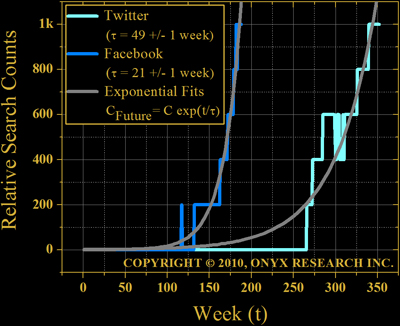_October2013_small-c5284e74ed9ef79f612813617b47061d92bf282e0f0f8ff07179efcb1aa8cc1a.jpg)
|
Research & Analysis for Business and Investment Clients |
|
Fitting data to the model CFuture(t) = C exp(t/τ), the average growth rate is (1/τ) . Using all available data for Twitter (τ = 49 +/-1 week, 1/τ = 2.0%) and Facebook (τ = 68 +/-1 week, 1/τ = 1.5%), Twitter is currently growing faster than Facebook.
The simple exponential model overestimates growth during some weeks and underestimates growth at others. Differences reflect changes in user and country behavior (numerous countries have blocked Facebook). Numbers are also strongly influenced by competitors. Attention shifts from MySpace customers to Facebook, fueling strong growth.
Fitting all available data gives average values, which can be used to compare growth rates to other companies, but compares growth at different company maturities.
Twitter started nearly three years after Facebook. In that time Facebook grew dramatically (three year delay highlighted with green dotted lines in figure 2). We want to compare the rates at which Facebook and Twitter attain the same search query value (1k in this case). This, more accurate, comparison is shown in figure 3.
 Figure 3. Twitter and Facebook average early-stage growth rate comparison (Facebook data truncated at 1k to match Twitter's current 1k search count - absolute search query numbers unavailable).
Figure 3. Twitter and Facebook average early-stage growth rate comparison (Facebook data truncated at 1k to match Twitter's current 1k search count - absolute search query numbers unavailable).
Fitting data capped at 1k, Twitter (τ = 49 +/-1 week, 1/τ = 2.0%) and Facebook (τ = 21 +/-1 week, 1/τ = 4.8%) data indicate Facebook captured users faster (almost 2.5X faster) than Twitter early on.
Outcomes & Conclusions
Facebook and Twitter are both growing impressively, but Facebook has two key advantages:
(1) Impressive market/attention share.
(2) A three year head start.

If user attention and numbers drive Twitter's business (a safe assumption), Twitter must, at minimum, meet Facebook's current growth rate (τ < 68 weeks, or, > 1.5% week-on-week growth) to stay competitive.
If such numbers prove difficult to meet or exceed, expect Twitter to form strategic partnerships creating a differentiated product, or sell the company.
Twitter must out-compete Facebook's news feed. Currently, Twitter differentiates service by limiting Digital Drivel to 140 characters. This constraint forces followers to share only links, not pet, food, or oh so social vanity shots.
With the recent "New Twitter" rollout, Twitter is clearly seeking to engage users with streamlined organization, easily accessible personal information about followers, and "Who to Follow" suggestions encouraging growth.
Facebook's news feed, to the contrary, commonly posts personal slices of life in vivid, had to be there-no one cares detail. Using Twitter as a human-driven content filter with commentary limited to a title and pointer (i.e., hyperlink) is Twitter's power (consultants call this strategy "less is more").
Facebook currently enjoys stupendous growth. Given significant privacy concerns (default opt-in settings can leave data openly accessible, making Facebook a liability, not an asset), Facebook is open to attack by a privacy sensitive competitor giving users better information control, default opt-out new feature rollouts, and a reduction in information irrelevant to many "Friends".
With 500 million "Friends" already, Facebook's growth may begin to slow. There are only ~2 billion with internet service.
MySpace is a lesson for Facebook. 500 million "Friends" are only ones and zeros gossiping between servers.
In a move both Twitter and Google are watching, Facebook unveiled a chat structured email inititative, which integrates with SMS. The MIT Technology Review article also discusses Google's rumored social network (to be launched soon).
Appendix - Model Rationale
We assume (dC/dt) = C/τ, where C is the search query count.
Solving this differential equation gives CFuture(t) = C exp(t/τ).
Looking for knowledge unique to your needs? Click on the Onyx Premier Black icon below.

